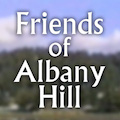24. URBAN NATURE PRESERVE II
RESERVA NATURAL URBANA II
RICHARD & LINDA BEIDLEMAN
766 Bayview Ave., Pacific Grove CA 93950
Location: California; Alameda Co.; Albany; Albany Hill Park; 37°54’N, 122°18’W; Richmond Quadrangle, USGS. Continuity: New. Size: 10.0 ha.
Description of Plot: The J-shaped plot includes the flat top and upper slopes of Albany Hill, which support a mature forest of planted eucalyptus trees (blue gum and manna gum), an understory of poison oak and toyon shrubs, and patches of grassland. The steep N slope has a closed-canopy woodland of coast live oak, with some California hazelnut and dense understory, leveling into a narrow grassland strip and a deciduous creekbottom (El Cerrito Creek) crowded with bushy arroyo willows. There are a paved parking area, a residential road into the area, and a system of developed and crude trails. There are two bird feeders in the plot.
Edge: The plot borders a lower hillside residential area to the E and S. To the W, eucalyptus trees extend down to a line of high-rise apartments then two busy and noisy freeways and finally the bay. To the N on the flats beyond El Cerrito Creek, there are residences and a creekside minipark with a small pond. The native hillside oak woodland extends beyond the plot to the NW a short distance.
Topography and Elevation: Albany Hill is an isolated sedimentary prominence near the E shoreline of San Francisco Bay, with a gradual slope from the summit down towards the S, and steep slopes on the other three sides. This is the only such hill along the immediate East Bay shore, which otherwise is a flat plain near sea level. Minimum elevation 8 m, maximum 99 m.
Weather: Mean start temp. 13.6°C (range 8—19°C). This was one of the wettest winters on record along the California coast; it is remarkable that there was no rain during visits. Temperatures tended to be moderate.
Coverage: 14.9 hrs; 8 visits (7 mornings, 1 afternoon): 18 Dec; 16, 17, 20 Jan; 2, 5, 19, 27 Feb.
Count: Dark-eyed Junco, 11.0 ind./visit (8 visits); California Towhee, 9.6 (8); Bushtit, 9.4 (5); Chestnut-backed Chickadee, 7.8 (7); Mourning Dove, 4.3 (7); Western Scrub-Jay, 4.3 (8); Lesser Goldfinch, 4.3 (7); American Robin, 3.8 (6); Yellow-rumped Warbler, 3.8 (7); House Finch, 3.5 (7); Anna’s Hummingbird, 3.4 (8); Steller’s Jay, 2.3 (6); Ruby-crowned Kinglet, 2.3 (7); Northern Flicker, 1.3 (5); Golden-crowned Sparrow, 1.1 (3): Downy Woodpecker. 1.0 (5); California Gull, 0.9 (4); Hermit Thrush, 0.9 (3); Red-tailed Hawk, 0.8 (5); Bewick’s Wren, 0.6 (4); Townsend’s Warbler, 0.6 (5); Song Sparrow, 0.6 (4); Turkey Vulture, 0.5 (1); Allen‘s Hummingbird, 0.5 (3); American Crow, 0.5 (2); Spotted Towhee, 0.5 (3); Brown Creeper, 0.4 (2); Black Phoebe, 0.3 (2); Red-breasted Nuthatch. 0.3 (2); Wrentit, 0.3 (2); Northern Mockingbird, 0.3 (2); Orange-crowned Warbler, 0.3 (1); White-crowned Sparrow, 0.3 (2); Sharp-shinned Hawk, 0.1 (1); Great Horned Owl, 0.1 (1); Red-breasted Sapsucker, 0.1 (1); Varied Thrush, 0.1 (1); MacGillivray’s Warbler, 0.1 (1); Fox Sparrow, 0.1 (1); House Sparrow, 0.1 (1). Total: 40 species; 81.9 ind./ visit (328 ind. / 40 ha).
Remarks: This city park, with its isolated, vegetated hill and associated creekbottom, surrounded by urban development, represents an ecological island. It supports a diversity of winter birds that generally only stray into adjacent areas. Most species occur in the oak woodland and deciduous creekbottom, with their native trees and bushes. The upper-slope eucalyptus forest has little birdlife except in brushy sites and especially around the bordering bird-feeding station. Understandably, many birds were habitat-specific: Steller’s Jay, Mourning Dove, flicker, and birds of prey in the open eucalyptus forest; Western Scrub-Jay, towhees, Bushtit, Bewick‘s Wren, and Wrentit in the brushy areas; chickadee, junco, Varied and Hermit Thrushes, and kinglet in the oak woodland; and hummingbirds, warblers, robin, finches, and sparrows in the deciduous creekbottom. The birds seemed little affected by the very wet winter weather.
Acknowledgments: Thanks to Dr. Barbara Ertter for botanical information.
J. Field Ornithology Journal, Autumn 1996, Vol. 67, No. 4 (supplement) pp 18–19

